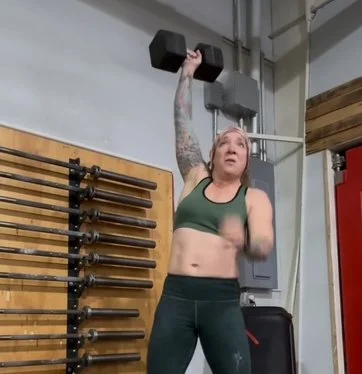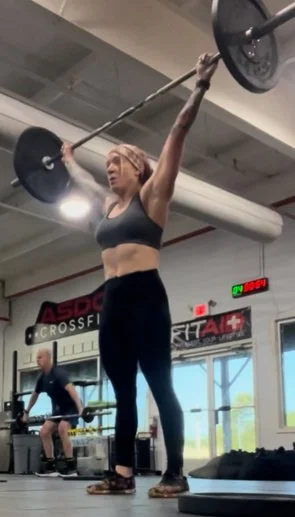Stay Strong, Move Smart: How to Avoid Injuries During Intense Summer Workouts
Summer workouts just hit different.
Maybe it’s the longer days or the extra dose of motivation, but we see a lot of people ramping things up—more CrossFit, more HIIT, more intense everything. And while we love the energy, we also see the consequences: rotator cuff shoulder injuries, low back issues, and re-injuries that could have been prevented.
At A Life In Balance in Flemington, NJ, we’re all about helping you keep moving without setbacks. We specialize in physical therapy for athletes of all levels—from weekend warriors to serious competitors—who want to train hard without hitting setbacks. That’s why we asked Tracy Bubalis—certified personal trainer (CPT), CrossFit coach, and head of our Transitional Fitness program—to share her insight on staying strong, moving smart, and making the most of your summer workouts.
Expertise in CrossFit Injuries and Physical Therapy for Athletes
Tracy Bubalis isn’t just our Transitional Fitness expert—she’s also a certified CrossFit trainer with firsthand experience in both the rewards and risks of high-intensity training. She works closely with our physical therapy team to support athletes during recovery and beyond, helping them move smarter, lift better, and avoid re-injury. It’s this blend of personal training and physical therapy for athletes that makes ALIB’s approach so effective.
“Becoming a CrossFit trainer has really forced me to take a look at different athletes' (and my own) movement patterns,” says Tracy. “To be able to move efficiently for longer and lift heavier, form and movement patterns are very important to avoid injury.” Integrating physical therapy and preparatory conditioning into her repertoire has helped her avoid injuries while helping others do the same.
Why Intense Workouts Lead to Injury—Especially in Summer
When you add higher summer workout levels to more intense activities like pickleball, CrossFit, HIIT, etc., you have a potent cocktail of heavy lifting, high-impact movements, quick direction changes, and explosive movements that can put more stress on muscles and joints than they’re used to. This higher intensity and these types of demanding movements aren’t just about summoning the mental motivation to push through, although that’s definitely part of the equation. To avoid injury, you also need correct form, balanced strength, breathing techniques, and adequate recovery so you don’t outpace your body’s readiness—especially in key areas like your joints, back, shoulders, knees, ankles, and hips. A Rutgers University study discovered an increase in such injuries connected to the growing popularity of these higher-intensity workouts between the years of 2007 and 2016, a trend we see continuing today here at ALIB.
“Most of the types of injuries I see, especially CrossFit injuries, are shoulders and low back,” Tracy explains. “Low back usually stems from lifting too heavy without proper form. Shoulder issues are typically caused by kipping (gymnastic swings) while doing pull-ups or other hanging movements. This is why, as a coach, I promote strict movements to build strength before adding kipping to the movement.”
Some of the most common injuries from intense workouts we see here at ALIB include:
Shoulder strain (e.g., rotator cuff issues)
Joint strain
Low back pain
Tendonitis
Knee injuries
Ankle injuries
Older injuries re-aggravated
These injuries often stem from doing too much, too soon—especially after recovering from a previous injury or time off. Without the right balance of strength, mobility, and form, even the most motivated athletes can find themselves back in rehab. It’s important to balance the motivation to work hard with the clarity and understanding about how balanced movement and your level of personal conditioning can impact your results, for good or ill. Physical therapy for athletes at all levels, from beginners to professionals, can help build the body awareness, balance, and conditioning needed for injury avoidance.
Listen to the Warning Signs—Before They Sideline You
Tracy advises people to listen carefully to their bodies as they enter the summer workout frenzy. She picks rotator cuff injuries, one of the most common CrossFit injuries she sees, to demonstrate what people should watch out for to catch problems early so they don’t become full-blown injuries:
“Watch out for consistent, nagging shoulder pain or feeling a consistent click in the shoulder during movement,” she says. “This is your shoulder telling you that it is not up for a hanging or overhead movement. Listen to it!"
This doesn’t mean just stop an activity altogether, however. What it does mean is that your body needs some extra conditioning and work before proceeding with certain movements. And this goes for all parts of the body, not just the shoulders.
“You don’t need to be injured to take action,” explains Tracy. “Preventative care is often easier and better than rehab.” This is where Tracy’s transitional fitness approach comes in handy.
How Transitional Fitness Helps You Move Better, Not Just Harder
During physical therapy here at A Life in Balance, one of the first steps is creating a blueprint that shows how each muscle and system in your body works, particularly focusing on where the imbalances and overcompensations exist. Each blueprint is unique to the individual. Physical therapy focuses on moving that blueprint into a place of balance where each part of the body works more harmoniously with the other parts. This helps current injuries recover while lowering the risk of future injuries. This blueprint doesn’t end once physical therapy is over, however. It's a living blueprint that evolves with you and can move with you into the future.
“Transitional Fitness helps athletes who are discharged from PT (or close to being discharged) by taking the client's blueprint and strengthening muscles that are being compensated for by other parts of the body, while releasing the overactive muscles,” explains Tracy. "Once clients feel comfortable enough and are confident in their recovery, CrossFit or any style workout increases the intensity and facilitates a wider variety of movements.”
As ALIB’s one-on-one transitional fitness trainer, Tracy works hand-in-hand with your physical therapist on those important “next steps” that continue to help you find balance and come back into activity stronger. The primary goals of transitional fitness training include:
Rebuilding strength where it matters
Correcting movement patterns
Improving posture, breathing, and joint stability
One-on-one support in these areas, working with your personal blueprint, not only helps you recover from injury, but it can also help people who want to start a new activity safely, and also those who want to increase their intensity and ramp up their workouts while lowering the risk of future injuries.
Who’s Transitional Fitness For (and Why It Works)
Our Transitional Fitness Hunterdon County program is perfect for a wide range of people, including:
CrossFitters and any athletes easing back into training after a period of inactivity
People who want to begin a more intense workout regimen than they currently have
People recovering from recent injuries or rehabbing old injuries
Athletes who want to come back strong after a pause in activity
Anyone who wants guidance—not guesswork—when returning to movement
This means anybody, really. You don’t have to be an “athlete”—just someone who cares about moving better and not getting injured when starting a new activity or deciding to ramp up your fitness with any new or unfamiliar form of exercise that is more intense than what you’re currently doing.
“ALIB has a very different approach to PT than ones I have experienced, which is why I love it!” says Tracy. "Rather than targeting the 'hurt' area, the therapists do intensive evaluations to determine muscle compensations. The focus is core to extremity and proper breathing, as well as releasing overactive muscles and strengthening underactive muscles. This is something that can help anyone."
Keep Moving Forward—With the Right Support with Physical Therapy in Flemington, NJ
No matter where you're starting from, ramping up your activity should feel exciting—not overwhelming. But pushing into new levels of fitness doesn’t mean you have to figure it out alone.
Whether you’re bouncing back from injury or building up to something bigger, our team in Flemington, NJ offers physical therapy and Transitional Fitness programs that help you move smarter, stay balanced, and train with confidence.
Even if you're traveling this summer, we’ve got you covered—virtual physical therapy sessions are available to help you stay on track from anywhere.
Take the next step with support that’s built around you.


